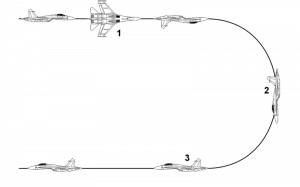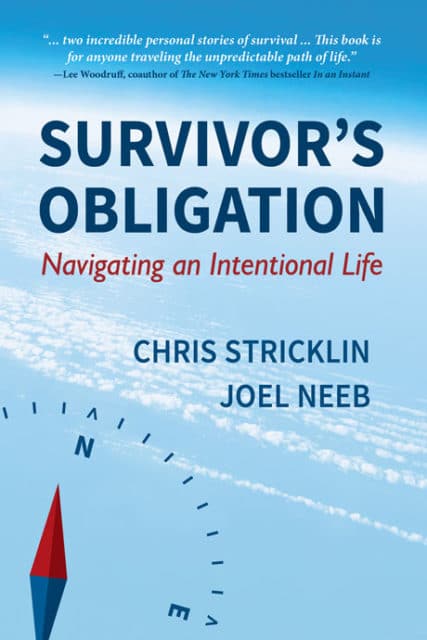Survivor’s Obligation
In 2003, an unbelievable photograph was taken of Captain Chris Stricklin ejecting from an F-16 during a Thunderbirds aerial display. I wrote about it a few years ago: Ejection 0.8 Seconds Before Impact.

Stricklin was flying Thunderbird 6, performing the Split S manoeuvre as a part of his solo performance with the Thunderbirds.
The Split S (known in the RAF as the Half Roll and in the Luftwaffe as the Abschwung) is a dog-fighting technique used to disengage from combat. The pilot half-rolls his aircraft so that he’s flying upside down and then dives away in a descending half-loop, pulling out so that he’s flying straight and level in the opposite direction.

Captain Stricklin had performed the Split S manoeuvre over two hundred times but this time something went wrong. He realised that he did not have enough vertical space to pull out of the half-loop, leading to his last-second ejection. Amazingly, he sustained only minor injuries.
The investigation on the accident concluded that the crash was caused by pilot error.
According to the accident investigation board report released today, the pilot misinterpreted the altitude required to complete the “Split S” manoeuvre. He made his calculation based on an incorrect mean-sea-level altitude of the airfield. The pilot incorrectly climbed to 1,670 feet above ground level instead of 2,500 feet before initiating the pull down to the Split S manoeuver.
When he realized something was wrong, the pilot put maximum back stick pressure and rolled slightly left to ensure the aircraft would impact away from the crowd should he have to eject. He ejected when the aircraft was 140 feet above ground — just eight –tenths of a second prior to impact. He sustained only minor injuries from the ejection. There was no other damage to military or civilian property.
Stricklin’s home base at Nellis is at 2,000 feet whereas Mountain Home is at 3,000 feet, so the altitude he selected would have been correct at his home base. Contributing factors were the requirement for demonstration pilots to convert mean sea level and above ground level altitudes and performing a manoeuvre with a limited margin of error.
Since then, the Thunderbird pilots now call out Mean Sea Level (MSL) altitudes rather than Above Ground Level (AGL) and it is a new requirement to climb an additional one thousand feet before performing the Split S manoeuvre.
These changes were too late for Stricklin; however he continued to work with the US Air Force leading flight, ground and weapon safety programs and was awarded the CSAF Individual Safety Award in 2009.
As a direct result of his efforts, flight mishaps were reduced in nearly every category; down 50 percent in Class A, 70 percent in Class C, 44 percent in Class E, and 50 percent in Controlled Movement Area Violations.
Earlier this year, I received a message from Chris “Elroy” Stricklin himself.
Thanks for your write-up on my Mountain Home Flight. Would like to discuss with you my upcoming book, Survivor’s Obligation. This book is not about why I crashed; It’s about why I survived and how that has impacted my life. Let me know if you are interested in featuring a follow up article on your site.
Of course I was.
Stricklin teamed up with another pilot in the US Air Force, Joel Neeb, to write a striking and heartfelt book about suffering and survival. Survivor’s Obligation: Navigating an Intentional Life is a heartfelt but down-to-earth book.

Both of the USAF pilots suddenly found that their lives had changed irrevocably. The odds were against them: Stricklin should never have survived an ejection that close to the ground and Neeb was diagnosed with a rare and often fatal metastatic cancer while at the hospital gaining treatment for his son. Both men struggled to understand why they survived when others had died and questioned what they should do with their second chance. They felt compelled by what they call the survivor’s obligation to rethink and revisit their plans and to lead an “intentional life” to honour those who did not get that opportunity.
“We think our situations can help others grow in their own trauma. Because it’s not about ejecting from an aircraft or having unsurvivable cancer, it’s about dealing with your own trauma that you’re going through every day. And that’s how we challenge people to live every day to its fullest. We call it living intentionally.”
The two true stories give a clear view into the world of the US Air Force and the events that spiralled their lives out of control. But this history forms only part of this inspirational book about gratitude, love and leadership.
We’ve suffered. We’ve endured. But we’ve accomplished so much more than we ever thought possible. And we’re just getting started.
Neither author is afraid to admit to emotions and vulnerability even as they attempt to light a way for others to follow. Survivor’s Obligation offers a rare view into the lives of two strong men and the families that supported them.
Survivor’s Obligation is available as a hardcover on Amazon but not as a Kindle book unless you are in the US. It is available as an ebook for non-Kindle devices on MilitaryFamilyBooks.com.
I am flattered to have been asked to read it and I am happy to recommend it.








For anyone who has not been through such an experience, it must be impossible to imagine the psychological impact on the survivor.
I certainly can’t.
This book should allow a glimpse into the way these experiences have changed the lives – and the view on life – of the authors.
I certainly hope to get hold of this book one day.